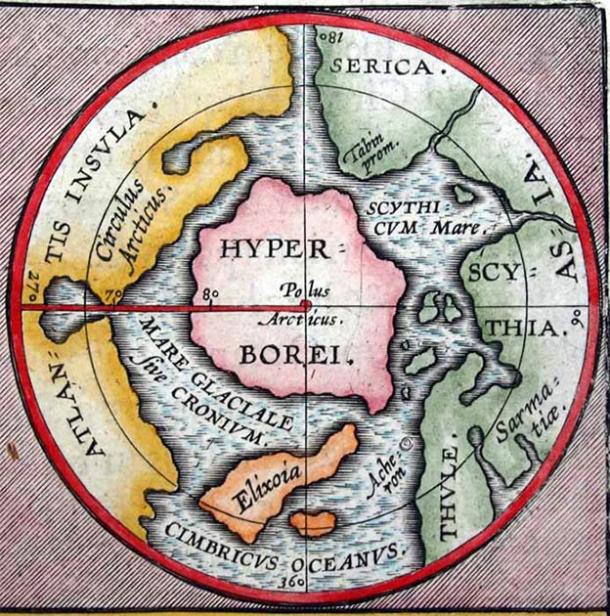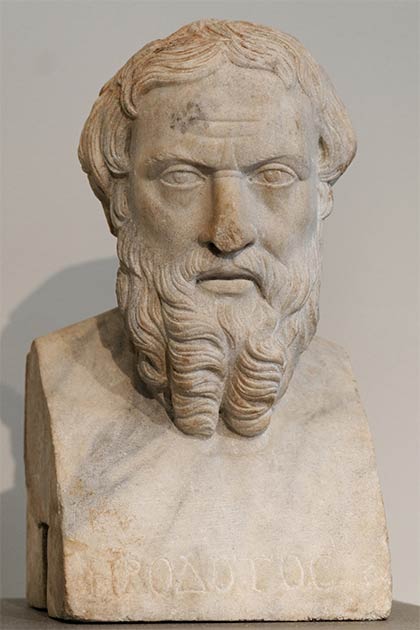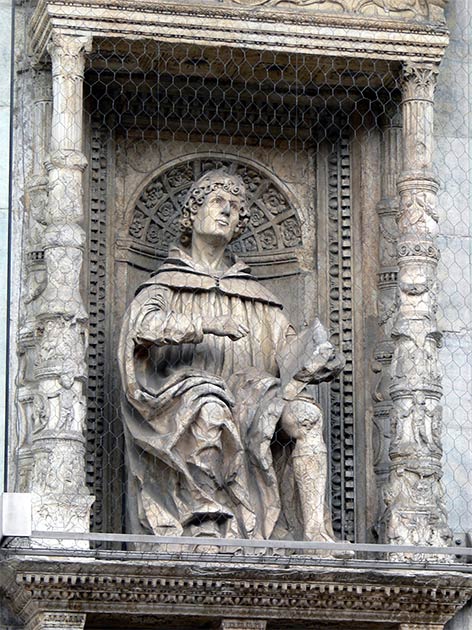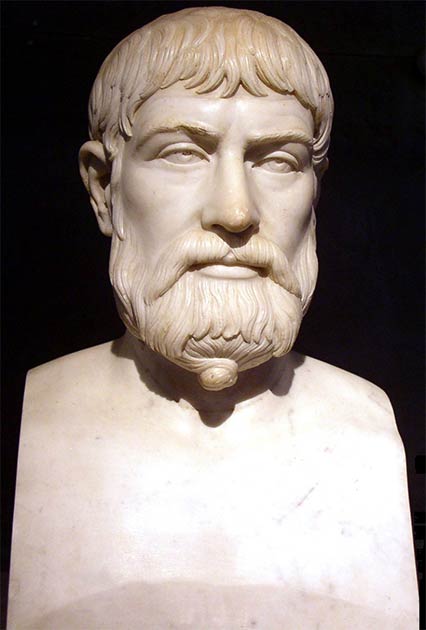
Hyperborea: Mythical Land That Fascinated Writers of the Ancient World
Hyperborea is a location in Greek mythology. The inhabitants of this mythical land are known as Hyperboreans, whom the ancient Greeks believed enjoyed extremely long lives. Hyperborea is mentioned by a number of Greek and Roman writers, including Herodotus, Pliny the Elder, and Pindar. Although Hyperborea is a mythical land, there has been speculation over the ages that it is a real place on earth. This has led to a number of theories about its exact location. In addition, attempts have been made to connect the Hyperboreans with real, historical peoples.
The name ‘Hyperborea’ may be translated to mean ‘Beyond the North Wind’, which is an indication of where the ancient Greeks thought this land was located. According to Greek mythology, the North Wind, personified by the god Boreas, lived in Thrace. Therefore, Hyperborea would logically be placed to the north of Thrace. Hyperborea, however, was one of the terrae incognitae (Latin for ‘unknown lands’) of the ancient Greeks and Romans. These were regions which have neither been mapped nor documented. In other words, Hyperborea might very well be a place that exists only in myth. And many of the stories told about Hyperborea and the Hyperboreans are quite unbelievable.
Hyperborea Mentioned Repeatedly by Herodotus
One of the ancient writers who mentions Hyperborea many times in his work is the Greek historian Herodotus. The so-called ‘father of history’ wrote about the Hyperborea in Book IV of his Histories. In one part of this book, Herodotus writes:
“Aristeas the son of Caystrobus, who came from Proconnesus, claimed in a poem that he visited the Issedones in a state of inspiration by Apollo, that beyond the Issedones lived a one-eyed race called the Arimaspians, beyond them there is the land of the gold-guarding griffins, and beyond them the Hyperboreans, all the way to the sea. All these people, from the Arimaspians on, except the Hyperboreans, are constantly attacking their neighbors.”

Ancient north pole map of mythical lands including the central continent of Hyperborea. (Abraham Ortelius / Public domain)
Herodotus seems to be skeptical about the existence of Hyperborea, but nevertheless informs his readers that this mythical land has been mentioned by two of ancient Greece’s most revered poets, Hesiod and Homer:
“None of the tribes living there, including the Scythians, have anything to say about the Hyperboreans. Perhaps the Issedones do, but I do not think so, because if they did the Scythians would have stories about them too, just as they do about the one-eyed people. Hesiod, however, has mentioned the Hyperboreans, and so has Homer in the Epigoni (if indeed Homer is the author of this poem).”
Herodotus then points out that most of the stories about Hyperborea are told by the inhabitants of the sacred island of Delos, “The overwhelming majority of the stories about the Hyperboreans come from Delos.” The historian goes on to relate some of the tales about the Hyperboreans, in which Delos, as one might expect, plays a prominent role. One of these, for instance, relates to the way sacred objects were transported from Hyperborea to Delos:
“The Delians say that sacred objects are tied up inside a bundle of wheat straws and are transported from the Hyperboreans first to Scythia, then westward as far as possible – that is, to the Adriatic – through a chain of successive neighbouring tribes, then south to Dodona (which is the first Greek community to receive them), then to the Gulf of Malia, where they cross over to Euboea, where they are passed from town to town until they reach Carystus, at which stage Andros is omitted, because the Carystians are the ones taking them to Tenos, and from Tenos the objects are conveyed to Delos. So this is how these sacred objects are said to reach Delos.”
The next story provided by Herodotus explains why the sacred objects were delivered in such a manner. According to the historian, the first time the sacred objects were sent to Delos, they were carried by two Hyperborean women, Hyperoche and Laodice (according to the Delians). The women were accompanied by five Hyperborean men who protected them and served as their escorts. These envoys, however, never returned home, causing the rest of the Hyperboreans to worry that the people they sent to deliver sacred objects in the future would not come back either. Therefore, they devised the method in which the objects were passed from one group of people to another, until they arrived in Delos.
Herodotus states that Hyperoche and Laodice accomplished their mission, and stayed in Delos, rather than returning home. After their deaths, the women were worshipped by the Delians and commemorated in a special ritual:
“Now, the death of the young women who came from the Hyperboreans is commemorated on Delos by a hair-cutting ritual performed by the girls and boys of the island. Before they get married, the girls cut off a lock of hair, wind it around a spindle and put in on the tomb (which is inside the sanctuary of Artemis, on the left as one enters, and an olive-tree has grown over it), and the Delian boys wind some of their hair around a twig and put it on the tomb as well. So that is how these Hyperborean women are worshipped by the inhabitants of Delos.”
Herodotus’ last story about the Hyperboreans is that of Arge and Opis, a pair of women who also travelled from Hyperborea to Delos. The women are said to have made the journey before Hyperoche and Laodice, though for a different purpose. Arge and Opis went to the island in order to pay tribute to Eileithyia, the Greek goddess of childbirth, in exchange for a quick and easy labor at childbirth.
According to Herodotus, the Delians claimed that the two women were accompanied by the gods themselves, and received different honors when they came to Delos. The women of the island begged gifts for Arge and Opis, whilst calling on the pair by name in the words of the hymn composed by Olen of Lycia in their honor. This practice has spread from Delos to the other Aegean islands and Ionia. Like Hyperoche and Laodice, the tombs of Arge and Opis are also found on the island: “This tomb of theirs is situated behind the grounds of the sanctuary of Artemis, facing east, right next to the banqueting-hall of the Ceans.”

Head of Herodotus, the “father of history” who wrote the most about Hyperborea. (© Marie-Lan Nguyen / Public domain)
Before ending his discussion about Hyperborea, Herodotus mentions in passing a figure called Abaris. As the historian says that he was not going to repeat the story of Abaris, it may be assumed that Herodotus’ readers were familiar with this tale. In any case, we learn from Herodotus that this Abaris was believed to be a Hyperborean, and that he “carried an arrow all the way around the world without eating anything.” Herodotus ends this section with a playful suggestion about people living beyond the South Wind, “But if there are Hyperboreans, there should also be Hyperenotians, people living beyond the south wind.”
Pliny The Elder and Hyperborea
Although Herodotus provides several stories related to the Hyperboreans, he does not talk much about Hyperborea itself, apart from its general location. Therefore, one has to rely on other ancient sources to fill in the gaps left by Herodotus. One such source is Natural History, written by Pliny the Elder, the Roman naturalist and natural philosopher. Pliny mentions the Hyperboreans in Book IV of his work, and begins with the general location of Hyperborea:
“Along the [Black Sea] coast [of Europe], as far as the river Tanais [known today as the Don], are the Mæotæ, from whom the lake derives its name, and the last of all, in the rear of them, the Arimaspi. We then come to the Riphæan mountains, and the region known by the name of Pterophoros, because of the perpetual fall of snow there, the flakes of which resemble feathers; a part of the world which has been condemned by the decree of nature to lie immersed in thick darkness; suited for nothing but the generation of cold, and to be the asylum of the chilling blasts of the northern winds.
Behind these mountains, and beyond the region of the northern winds, there dwells, if we choose to believe it, a happy race, known as the Hyperborei.”

Pliny the Elder of Rome who also wrote a lot about Hyperborea (Wolfgang Sauber / CC BY-SA 3.0)
Like Herodotus before him, Pliny seems to express his doubts about the existence of the Hyperboreans. Unlike the Greek historian, however, Pliny does not go straight into Delian-related Hyperborean stories. (Incidentally, the story about the Hyperboreans sending sacred objects to Delos via neighboring tribes can be found at the end of Pliny’s account of Hyperborea.) Instead, Pliny provides his readers with more details about Hyperborea itself:
“At this spot are supposed to be the hinges upon which the world revolves, and the extreme limits of the revolutions of the stars. Here we find light for six months together, given by the Sun in one continuous day, who does not, however, as some ignorant persons have asserted, conceal himself from the vernal equinox to autumn. On the contrary, to these people there is but one rising of the sun for the year, and that at the summer solstice, and but one setting, at the winter solstice. This region, warmed by the rays of the sun, is of a most delightful temperature, and exempt from every noxious blast.”
Pliny continues his account with information about the Hyperboreans themselves. Apart from referring to the Hyperboreans “a race that lives to an extreme old age,” earlier on, Pliny also wrote the following:
“The abodes of the natives are the woods and groves; the gods receive their worship singly and in groups, while all discord and every kind of sickness are things utterly unknown. Death comes upon them only when satiated with life; after a career of feasting, in an old age sated with every luxury, they leap from a certain rock there into the sea; and this they deem the most desirable mode of ending existence.”
- Eight Legendary Creatures from Greek Mythology That You Might Not Know About
- Thucydides Versus Herodotus: Who Was the Real Father of History?
- What Did Ancient Civilizations Believe Lay at The Edges of the Earth?
From Pliny’s work, it is clear that even in ancient times the exact location of Hyperborea was a puzzle. Several competing hypotheses about Hyperborea’s actual whereabouts are mentioned by the Roman writer. For instance, Pliny mentions some ancient writers claimed that Hyperborea is located on the edge of the shores of Asia. These writers argued that a people called the Attacori, who resemble the Hyperboreans, lived in that region, which has very similar conditions to Hyperborea. Other writers argued that the region lies “midway between the two suns, at the spot where it sets to the Antipodes and rises to us.” Pliny discounts this hypothesis, considering the “vast tract of sea which there intervenes” A third hypothesis states that Hyperborea is located “nowhere but under a day which lasts for six months,” and that the Hyperboreans sow in the morning, reap at mid-day, gather the fruits of the trees at sunset, and conceal themselves in caves at night.

Bust of the lyric Roman poet Pindar whose poems mention Hyperborea (Stas Kozlovsky / CC BY-SA 3.0)
Other Talk of Hyperborea
Hyperborea is also mentioned in works by ancient poets. These poetic works provide us with more information about this mythical land. The Hyperboreans, for instance, appear in Pindar’s Olympian Ode III. In his poem, Pindar claims that Heracles had travelled to Hyperborea to obtain an olive tree from its inhabitants. The hero begged for the tree “to make shade for all men to share, and for brave deeds of valorous spirits, a crown.” In another poem, Pythian Ode X, Pindar places the slaying of Medusa by Perseus in Hyperborea, and paints the region as a place of great happiness:
“The Muse is not absent from their customs; all around swirl the dances of girls, the lyre’s loud chords and the cries of flutes. They wreathe their hair with golden laurel branches and revel joyfully. No sickness or ruinous old age is mixed into that sacred race.”
Herodotus, Pliny the Elder, and Pindar were not the only ancient authors who wrote about Hyperborea. Other well known figures who mention this mythical region include Pausanias, Diodorus Siculus, Ovid, and Strabo.
The large amount of work written about Hyperborea by these ancient authors shows that there was a great fascination with this land. As a matter of fact, this fascination has survived till this day, as some have sought to identify the location of Hyperborea, which may help to prove its existence. Nevertheless, there is still no consensus to the location of Hyperborea, assuming this paradise even exists in the first place.
Top image: Boreas, Greek God of the North Wind, who is strongly connected with the mythical land of Hyperborea, abducting Oreithyia. Source: Giovanni Francesco Romanelli / Public domain.
By Wu Mingren
References
Atsma, A. J., 2017. Hyperborea. [Online]
Available at: https://www.theoi.com/Phylos/Hyperborea.html
Herodotus, The Histories
[Waterfield, R. (trans.), 1998. Herodotus’ The Histories. Oxford: Oxford University Press.]
Pindar, Olympian Odes [Online]
[Svarlien, D. A. (trans.), 1990. Pindar’s Olympian Odes.]
Available at: http://www.perseus.tufts.edu/hopper/text?doc=Perseus%3Atext%3A1999.01.0162%3Abook%3DO.
Pindar, Pythian Odes [Online]
[Svarlien, D. A. (trans.), 1990. Pindar’s Pythian Odes.]
Available at: http://www.perseus.tufts.edu/hopper/text?doc=Perseus%3Atext%3A1999.01.0162%3Abook%3DP.
Pliny the Elder, Natural History [Online]
[Bostock, J., Riley, H. T. (trans.), 1917-32. Pliny the Elder’s Natural History.]
Available at: http://www.perseus.tufts.edu/hopper/text?doc=Perseus:text:1999.02.0137
Prof. Geller, 2016. Hyperborea. [Online]
Available at: https://mythology.net/greek/mortals/hyperborea/
The Editors of Encyclopaedia Britannica, 2007. Hyperborean. [Online]
Available at: https://www.britannica.com/topic/Hyperborean
thedelphiguide.com, 2020. Hyperborea. [Online]
Available at: https://thedelphiguide.com/hyperborea/
















Comments
Hyperboreans were the Ancient Finnish people according to the Bock Saga, who lived before the ice age 50 million years ago. Ice age began after the pole of the earth fell to where it is now 23.4 degrees but before that was perfectly perpendicular to the solar orbit. So that place was called Hell, it was the garden of Odin where the first man and woman were born, 7 islands were around it, and now it’s called Helsinki. After hell froze over from the first ragnarook, it was cut off from the world the one race of human divided into 13 races. Before everyone was brown, but during the ice age people evolved into different races. Nevertheless there is record of these people all over the world, India China America Egypt, they all look back to a paradise at the center of the world. More info at: bocksaga.info
With all different ancient cultures stories about a great flood, perhaps Hyperborea was a land that existed in pre-flood times that eventually passed into myth and legend centuries later. Just a thought.
Immediately when I saw the article I thought about proposing to watch the video you have linked at the bottom!